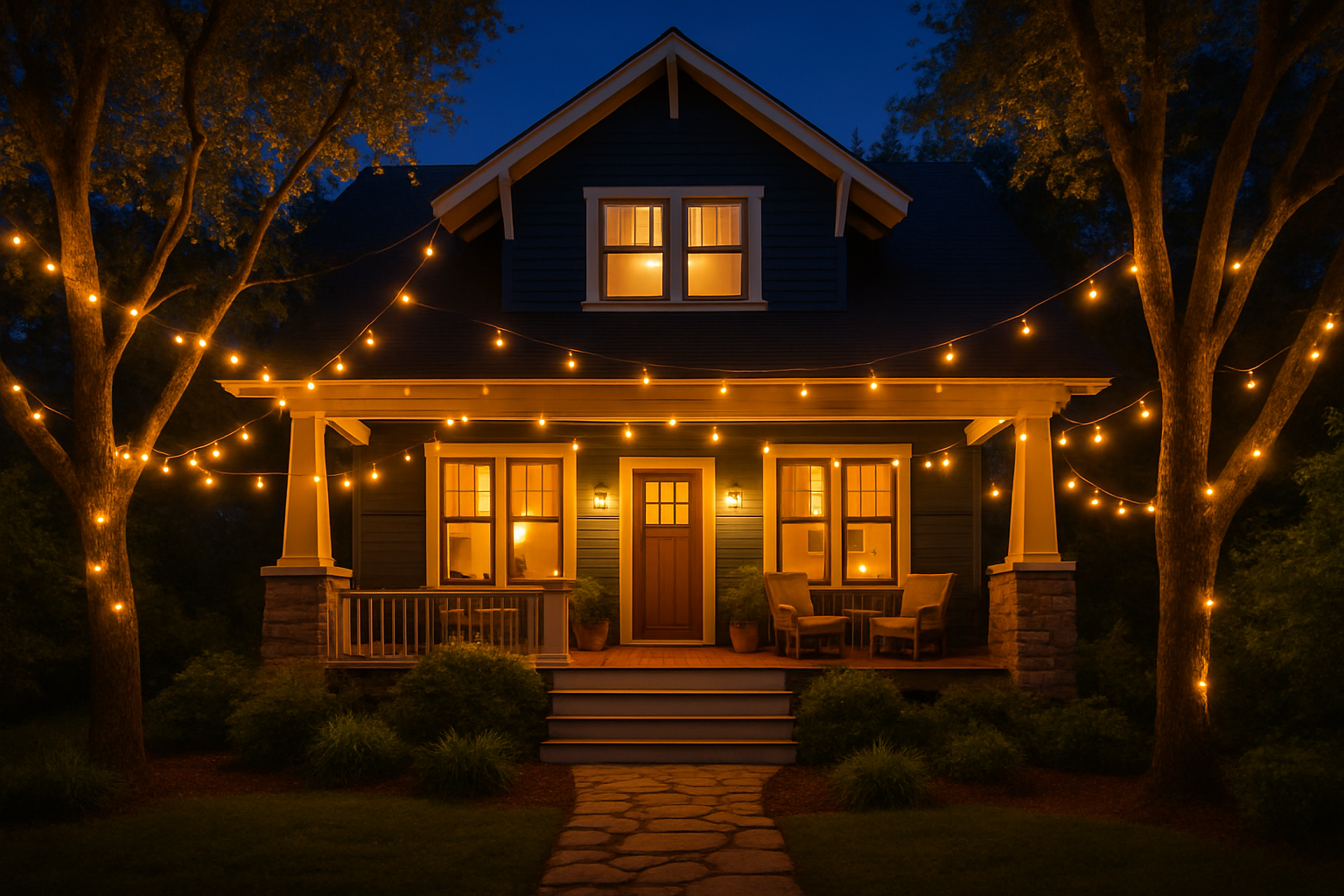Transform your outdoor space into a magical retreat with the warm glow of string lights. Whether you're planning a special event or want to create a permanent, enchanting atmosphere in your backyard, knowing how to hang outdoor string lights properly is essential. But how exactly should you hang outdoor string lights?
The most secure method for hanging outdoor string lights is to install guide wires between sturdy mounting points (like posts, trees, or buildings), then attach the string lights to the guide wire using zip ties or light clips spaced every 3-4 feet.
While this basic approach works well, there's much more you need to know to ensure your lights are safely and beautifully installed. From choosing the right mounting hardware for your specific situation to understanding electrical safety requirements and creating different lighting patterns, the details can distinguish between a professional-looking installation and one that could fail during adverse weather conditions.
Shop UBL’s Home Lighting Collection
What Type Of Hardware Do You Need For Hanging Outdoor String Lights?
The mounting hardware you choose depends on where you're hanging your lights. For permanent installations on buildings, use heavy-duty screw hooks or eye bolts secured into wall studs or fascia boards. When mounting to trees or posts, cup hooks or screw eyes work well. For guide wires, use galvanized steel cable (minimum 1/16-inch thickness), cable clamps, and turnbuckles for tension adjustment.
Always ensure your mounting points can support at least 15 pounds of tension. Install intermediate support posts to prevent sagging for distances over 40 feet. Include strain reliefs at power connection points to protect electrical connections from stress.
How To Create Different Lighting Patterns For Maximum Visual Impact
The pattern you choose can dramatically affect the ambiance of your space. The most common designs include straight runs, zigzag patterns, and perimeter lighting. Create a grid pattern by running multiple parallel guide wires for a romantic canopy effect. Allow some natural dips between mounting points for a more casual look, but avoid droops greater than 6-8 inches.
Consider the height of your installation carefully - lights should typically be hung 8-10 feet high for optimal illumination and to avoid glare. Lower heights of 6-7 feet can create a more intimate atmosphere for dining areas.
What Safety Considerations Should You Keep In Mind?
Electrical safety is paramount when installing outdoor string lights. Use only UL-listed lights rated for outdoor use, and ensure all connections are weatherproof. Install a GFCI-protected outlet if one isn't present, and use outdoor-rated extension cords when necessary.
Calculate your total power draw before installation - most residential circuits can handle 15-20 amps. Don't exceed the manufacturer's recommended maximum number of connected strings when connecting multiple strands. During installation, avoid placing lights near water features or areas where they might be damaged by lawn maintenance equipment.
Check your local building codes. Some areas have specific requirements for outdoor lighting installations, particularly regarding height restrictions and electrical connections.
How To Maintain And Store Outdoor String Lights
Regular maintenance ensures your lights continue looking beautiful and functioning safely. Inspect your lights monthly for wear, loose connections, or damaged bulbs. Clean the bulbs periodically with a damp cloth to remove dust and debris that can dim their brightness. During cleaning, check that all connections remain weatherproof and that guide wires haven't loosened.
For storage, avoid the common mistake of winding lights into a tangled ball. Instead, wrap them around a piece of cardboard or use a storage reel. If possible, remove the lights during severe weather events, and always take them down if you notice any damage to the wiring or mounting system.
What Are The Best Types Of Outdoor String Lights To Buy?
Commercial-grade LED string lights are typically the best choice for permanent outdoor installations. They're more durable than residential-grade options and often come with replaceable bulbs. Look for lights with thick, weatherproof cords and sturdy sockets. LED bulbs use about 75% less energy than traditional incandescent bulbs and can last up to 25,000 hours.
Consider bulb spacing when purchasing - lights spaced 12-15 inches apart provide good illumination without appearing cluttered. Choose lights with standard E26 bases for maximum flexibility, allowing you to change bulb styles easily. Edison-style bulbs create a vintage atmosphere, while globe bulbs offer a more modern look.
Although commercial-grade lights may initially cost more, their longevity and durability make them more cost-effective in the long run. Avoid cheaper plastic-socket lights, as they deteriorate quickly in outdoor conditions.
Time To Light Up Your Space
Before rushing to hang your lights, sketch out your desired lighting pattern and measure all spanning distances. This planning step will help you calculate exactly how many light strings you'll need and what mounting hardware is appropriate for your installation. Once you have your plan, you can confidently purchase your materials and create the enchanting outdoor space you've dreamed of.
FAQs
What's the typical cost for a quality outdoor string light setup?
Quality commercial-grade LED string lights typically cost $40-150 per 50-foot strand, with additional expenses for mounting hardware ($25-75) and installation supplies ($30-50). While residential-grade options may cost less initially ($15-40 per strand), they often require replacement within 1-2 seasons, making commercial-grade lights more economical long-term despite the higher upfront investment.
How difficult is it to install outdoor string lights for a beginner?
Most string light installations are beginner-friendly DIY projects requiring basic tools (drill, ladder, wire cutters) and 2-4 hours for a typical backyard. The most challenging aspects are typically installing mounting points and ensuring proper tension. Having a helper makes the process significantly easier, particularly when hanging lights across longer spans or at greater heights.
How do I choose the right brightness for my outdoor space?
For ambient lighting in intimate settings, choose bulbs with 20-40 lumens per foot of string lighting. For brighter functional lighting (dining or activity areas), look for 40-80 lumens per foot. Most commercial-grade string lights list total lumens on the packaging – divide by the strand length to calculate lumens per foot. Dimmable options provide the best flexibility for different occasions.
Can outdoor string lights withstand rain, snow, and high winds?
Commercial-grade string lights with weatherproof ratings (look for IP65 or higher) can withstand direct rain, snow, and moderate winds when properly installed with guide wires. However, extreme conditions like hurricanes, ice storms, or sustained winds over 45 mph may damage even high-quality installations. Consider installing a quick-disconnect system to easily remove lights before severe weather events.
What are the most common mistakes people make when hanging outdoor string lights?
The most frequent errors include: underestimating the number of lights needed (measure your space before purchasing); using indoor-rated lights outdoors (always check for outdoor/weatherproof ratings); mounting directly to gutters or weak structures that can't support the weight; improper electrical connections not protected from moisture; and failing to create adequate tension with guide wires, resulting in sagging or swinging lights.
How far apart should I place mounting points for outdoor string lights?
For optimal support and minimal sagging, install mounting points (poles, hooks, etc.) every 15-25 feet along your planned light path. For heavier commercial-grade lights or in windy areas, decrease this distance to 10-15 feet to prevent excessive tension on the lights or guide wires.
Do LED string lights use a lot of electricity?
LED string lights are extremely energy-efficient. A typical 50-foot commercial-grade LED string with 50 bulbs consumes only 25-35 watts – approximately 90% less energy than comparable incandescent options. This translates to around $0.50-$1.00 per month in electricity costs if run 4 hours nightly, making them highly economical for long-term or daily use.
What's the best way to secure string lights to guide wires?
Use UV-resistant zip ties or dedicated light clips spaced every 3-4 feet along the guide wire. Ensure they're tight enough to prevent sliding but not so tight that they damage the wire insulation. For professional installations, specialized S-hooks or carabiners designed for string lights provide secure attachment while allowing for easier seasonal removal.


